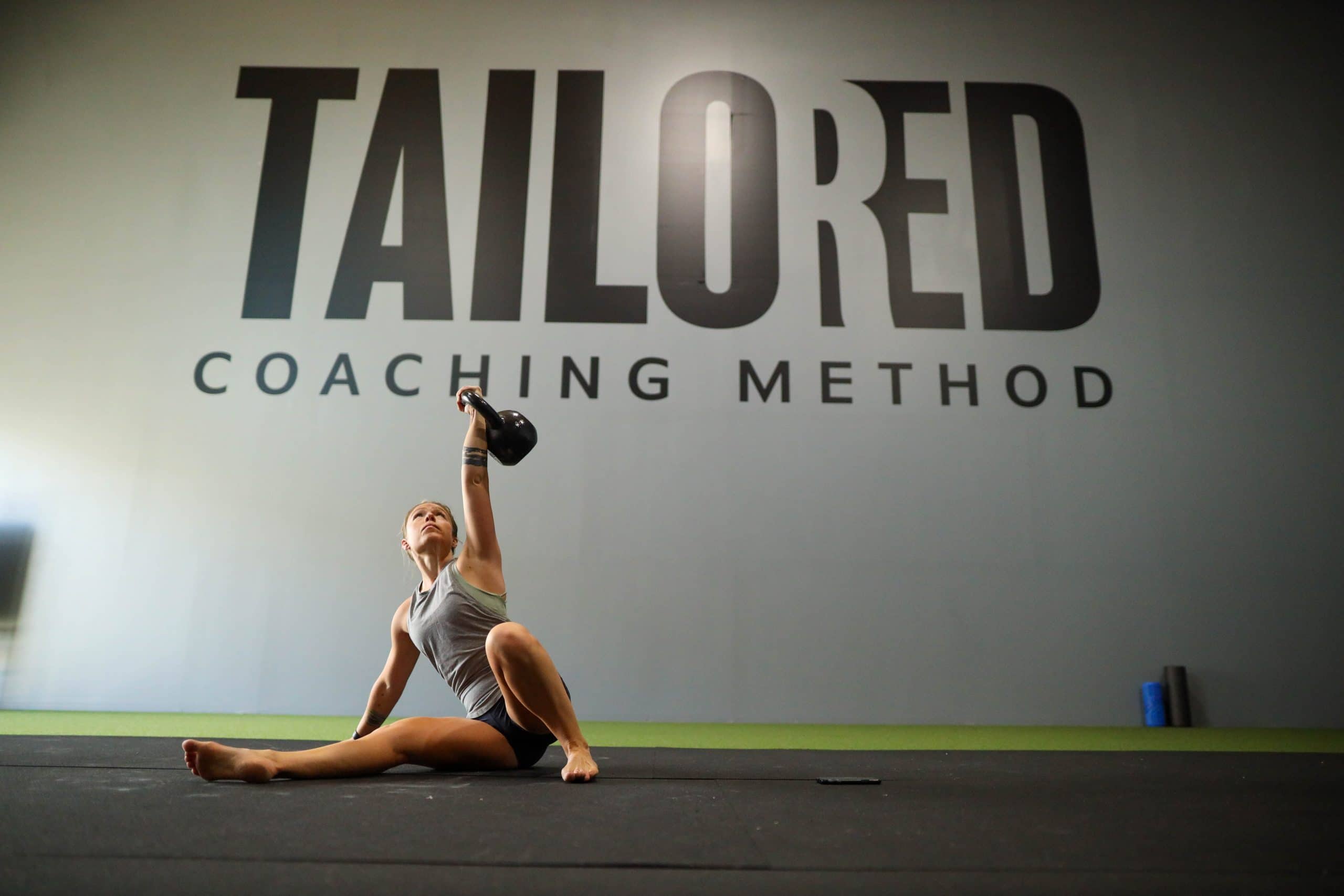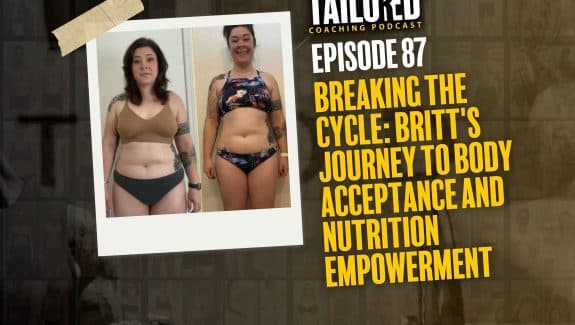We appear to be going about health and weight loss all wrong. As nutrition coaches, we’re often seen as contributors to diet culture because a lot of our clients come to us seeking weight loss. However, we’ve made it part of our mission to educate our clients on nutrition and their bodies so they not only reach their physical goals, but they have an innate understanding of how to sustain it for the rest of their lives. When addressing physical goals, like weight loss, it requires addressing the behaviors that led to the increase in weight, reduction in health, and poorer quality of life in the first place. It’s been recommended that behavior modification should be one of the first approaches to obesity treatment (4) which extends beyond a simple meal plan or any of the fad diets we’re bombarded with daily.
At Tailored Coaching Method, we take into account all the details of a client because we understand that it’s the day-to-day minutiae that add up to one’s behavior and that can either lead down an unhealthy path or a healthier one. When our clients come to us, the majority of them have found themselves on the unhealthy path and it doesn’t happen overnight. Behavior change starts with the details and strategies emphasize making small, but sustainable changes (4) when it comes to weight loss or other health and physical goals. There are two big zones we’ll focus on here: the START of change and the CONTINUATION of it. Finally, at the end, we’ll cover exact ways you can start your journey and level up as you keep going because “the secret to getting results that last is to never stop making improvements” (8).

Optimizing From the Start
While we promote committing to making positive changes to your life on ANY day and that waiting for the “right” time is only putting off reaching your goals, we’re also big fans of looking for ways to set you up for success. There’s something to be said for that feeling you get as New Year’s Day approaches or you have a birthday. In fact, there’s a name for it – it’s called the Fresh Start Effect.
Psychologists have found that significant occasions throughout the year not only create greater opportunities for changing behavior but amplify the positive associations towards implementing those changes (1,3). Relying on motivation doesn’t always work in our favor since it’s not a constant feeling, but that doesn’t mean we can’t use it to our advantage and in a strategic fashion. Temporal landmarks that signify a fresh start or new beginning – think, a holiday, birthday, season, or even a new week – have shown a higher likelihood of people initiating change as well as an increase in their desire towards those required behaviors (3).
These occasions create opportunities for change for a couple of reasons. First, people tend to view these temporal landmarks as the start of a new cycle, thus separating what came before from what comes next. Rather than feeling held back by old habits and behaviors, people are better able to disconnect from their past (even if that’s as recent as yesterday) and look towards the future (i.e. today or tomorrow) during these occasions. Second, the fresh start effect allows people to shift focus from the details that encompass change and focus on the big picture (1). While, yes, the daily habits and details are what build into long term sustainable change, if you’re not simultaneously visualizing your long term success, you may be missing out on an important part of the equation. We’re constantly trying to find that sweet spot of daily fulfillment that builds into long term satisfaction.
Interest in changing eating behaviors (like starting to count macros or go into a fat loss phase) as well as starting a new exercise program or signing up for a gym membership increase during these temporal landmarks (1). New Year’s Day is one of the most common partly due to it being a new year as well as it coming after the holidays. However, waiting until the new year isn’t necessary to optimize on the fresh start effect. The start of a new week or month are also shown to be significant in piquing people’s interest in diet and exercise (1) and happen much more frequently in the year. Furthermore, any personal life change like a birthday, moving to a new place, getting married, having kids, or starting a new job or semester at school can create the feeling of a new beginning or chapter in your life. What that means is the opportunities to encourage change and follow through on your intentions are abundant throughout the year.
Now, maintaining that momentum is the next step because what we want to avoid is falling into the vicious cycle of “I’ll just start over on Monday”. This is where HOW you implement change, the role your environment plays, and factoring in some version of accountability become necessary.
The Power of Your Environment
In Atomic Habits, James Clear notes, “Environment is the invisible hand that shapes human behavior” (8) – which emphasizes the power and influence of the environment on daily decision making but also can empower us to be the architects of our space. Relying on willpower in environments that are designed to work against our efforts to be healthy (i.e. highly palatable foods, delivery for everything, convenience of restaurants, drive-thrus, and packaged foods, etc.), is exhausting. We can change that, however, as research shows that creating a supportive environment helps to counteract the internal struggle of self-control we often face (2).
There are a couple different approaches we need to take in designing our environments, both of which are broken down in his book, Atomic Habits. First, we need to make the cues to make the positive habits we’re after more obvious, easier, and more attractive. Second, we need to make the habits we’re trying to change less obvious, more challenging, and less attractive. Lastly, it comes down to putting in the reps to build good habits up and break bad ones (2,8). Design your environment intentionally, but understand, you still need to put in the work.
When we think of this around our nutritional habits, our common environments include our home and workplace as well as the city we live in and drive around everyday. This also extends to the people we surround ourselves with and our innate desire to feel like we belong. We’re constantly picking up cues that direct our decision making around what to eat. The more we control our environment, the more we control our decisions and the easier it will be to positively change our behaviors. If we position ourselves in environments and around people that reinforce the desired behaviors (like having a training buddy or inviting your partner to partake in cooking healthy meals at home), the easier and more attractive they become for us both with initiating change and maintaining it.

The Power of Routine
Coupled with our environments, our daily routines work similarly in reinforcing unhealthy or healthy behaviors and are critical when we think of creating lasting change. Research shows that stable routines are what allow us to build the consistency and frequency required to make a behavior habitual (6,8). For example, when you plan your workout at a similar time of day each week, it’s more likely to happen and continue long term.
It’s important to note that routine doesn’t mean restriction or rigidity and those contexts can actually work against us. Routines create structure and it’s finding or creating freedom within that structure that allows us to truly thrive. The behaviors that get reinforced both within a routine and when we’re caught off guard are the ones that become the strongest (6). This is largely why we are huge proponents of flexible nutrition and tracking macros. It provides us structure with macronutrient and calorie targets to support our goals without so much rigidity that there’s no wiggle room. This way, if we are out of town or go out for a meal or want to celebrate a special occasion, we’ve essentially trained ourselves to make the best decisions under any circumstances because we’ve learned where flexibility fits in.
Accountability, Self-efficacy, & Self-monitoring
After the first step of deciding to make a change, identifying the variables that contribute to behavior change and understanding how to best track them are critical steps. It’s not as simple as eat less, move more if your goal is fat loss, for example, and, even if it was, that provides a very vague sense of direction. What you don’t track, you can’t change. Having a system that allows you to track different variables consistently creates greater awareness and self-reflection, leading to automatic changes in food choices that promote weight loss (5).
Factors such as self-efficacy (self-belief) and self-control play major roles in determining a person’s success with behavior change (2,4). One of the reasons we have the majority of our clients track their calories and macros is because it gives them immediate control over their nutrition while educating them around what nutrients they need. Tracking macros provides our clients with the autonomy to continue making their own food choices from a place of awareness that strict meal plans don’t. In order for behavior change with nutrition and exercise to be sustainable, a level of self-efficacy and self-monitoring is required.
Other variables outside of macros have also shown to be beneficial to track when it comes to body composition changes and increasing one’s awareness of their behaviors. These variables include weigh-in frequency, daily steps, minutes of high intensity activity, and frequency of food log days (7). The most important thing to note with tracking these variables is frequency and consistency – it may not come as a surprise that greater frequency across the board is associated with greater weight loss (7).
Whether our clients track all macros, just protein and calories, or only habits (no macros), they are tracking MULTIPLE things every day. Depending on your goals and level of experience, what you track and how often will vary, but the point remains that behavior change requires action and the accountability of working with a coach and monitoring aspects of your life frequently means the physical progress you’re seeking becomes a sustainable part of your life.
Direct Strategies to Elicit AND Sustain Change
Before providing a clear list of things you can do right now to create life-long behavior change, we highly recommend starting with small changes. In a culture that heavily promotes quick fixes and extreme diets, it almost feels counterintuitive to do one small thing differently as a starting point but there’s a reason the extreme approach only elicits an immediate reward that often results in rebounding heavily in the opposite direction. In Atomic Habits, James Clear sums it up by saying, “The holy grail of habit change is not a single 1 percent improvement, but a thousand of them. It’s a bunch of atomic habits stacking up, each one a fundamental unit of the overall system” (8).
Here’s how that might look and how a lot of our clients start:
- Start tracking all of your food so you build awareness immediately. From there, adjust your calories and macros for general health and to start working towards your goals.
- Start by reducing how often you eat out by 1x/week. Alternatively, you could also adjust the places you get food from. From there, gradually build until meals out become occasional at best.
- Start by adding a bit more protein to each meal plus an extra serving of fruit and vegetables to your day. From there, build up to 80-90% whole foods for your entire day.
- Start with replacing calorically-dense drinks with their zero-calorie substitutes (i.e. coke for diet coke) and gradually work into adding regular/naturally flavored water and tea as your primary beverages.
- Start with finding a meal structure that works for your schedule. From there, you can begin timing certain macros around your activity.
- Start tracking your steps and add a daily walk to your routine. From there, build up to a regular 10k steps/day.
- Start by getting to bed and waking up at the same time each day. From there, move up your bed time and/or extend your morning by 15 minutes until you’re getting at least 7 hours of sleep/night.
- Start with removing highly-palatable and calorically-dense foods from your house. From there, swap out whole food snacks for the packaged options and keep the processed snacks to a healthy minimum.
- Start by going to the gym 2-3x/week whether it’s a group class, personal training session, or following a program. From there, transition your focus to primarily strength training 3-6x/week following a progressive overload program.
It IS an exhaustive list which is where coaching comes in. We emphasize different factors in the above list based on the client. Some clients are already doing half of the things on the list when they start which allows us to focus our efforts elsewhere or on the next step. Other clients need to focus on 1-3 items first, build the consistency with those, and then we add a layer. The beauty of starting small is that consistency builds momentum and trust in the process. While motivation may be higher at specific times of year or around other significant points in a person’s life, it’s the daily action of intentionally incorporating healthy habits that leads to lasting behavior change.
Citations
1: Hengchen Dai, Katherine L. Milkman, Jason Riis (2014) The Fresh Start Effect: Temporal Landmarks Motivate Aspirational Behavior. Management Science
2: Angela Duckworth, K. M. (2019, April 17). Perspective | a smarter way to think about willpower. The Washington Post. https://www.washingtonpost.com/business/2019/04/17/smarter-way-think-about-willpower/.
3: Dai, H., Milkman, K. L., & Riis, J. (2015). Put Your Imperfections Behind You: Temporal Landmarks Spur Goal Initiation When They Signal New Beginnings. pss.sagepub.com. https://static1.squarespace.com/static/5353b838e4b0e68461b517cf/t/5730b8c9b654f9062918926d/1462810825925/2015_PsychSci.pdf.
4: Wilborn, C., Beckham, J., Campbell, B. et al. Obesity: Prevalence, Theories, Medical Consequences, Management, and Research Directions. J Int Soc Sports Nutr 2, 4 (2005). https://doi.org/10.1186/1550-2783-2-2-4
5: Hooker, S., Punjabi, A., Justesen, K., Boyle, L., & Sherman, M. D. (2018, April 1). Encouraging health Behavior Change: Eight Evidence-Based Strategies. Family Practice Management. https://www.aafp.org/fpm/2018/0300/p31.html.
6: Milkman, K. (2021, May 6). A flexible routine can help you change for good. strategy+business. https://www.strategy-business.com/article/A-flexible-routine-can-help-you-change-for-good.
7: Painter, S. L., Ahmed, R., Hill, J. O., Kushner, R. F., Lindquist, R., Brunning, S., & Margulies, A. (2017). What Matters in Weight Loss? An In-Depth Analysis of Self-Monitoring. Journal of medical Internet research, 19(5), e160. https://doi.org/10.2196/jmir.7457
8: Clear, J. (2018). Atomic habits: An easy & proven way to build good habits & break bad ones. Random House.






















































































































































































































































































































































































































































































